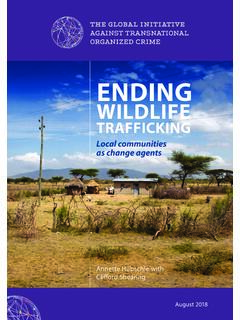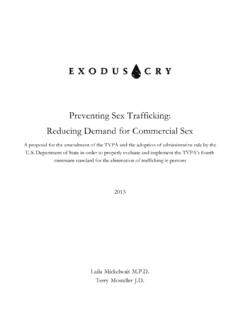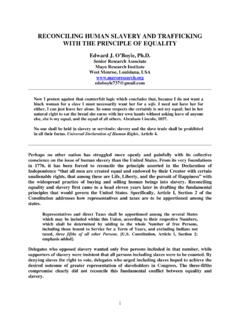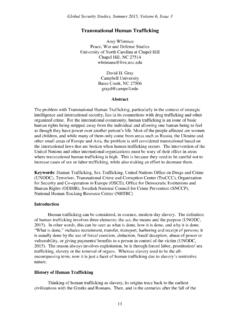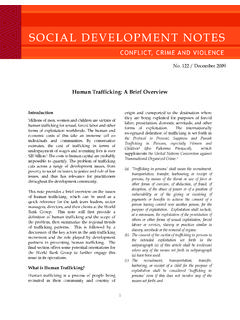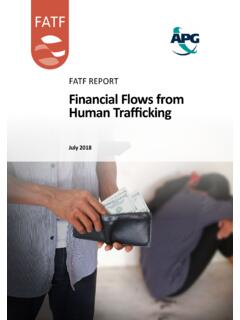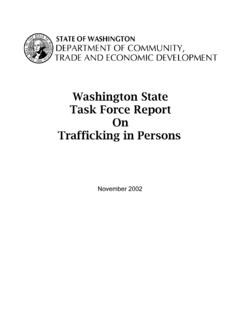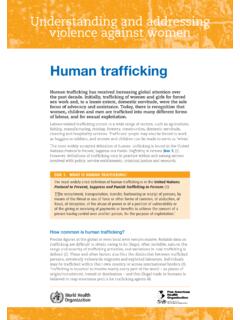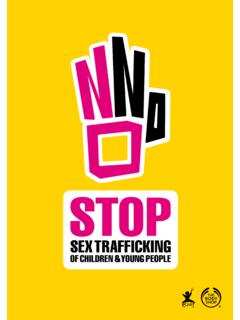Transcription of The Human Conveyor Belt : trends in human trafficking and ...
1 The Human Conveyor belt : trends in Human trafficking and smuggling in post-revolution LibyaM a r c h 2 017A N E T W O R K T O C O U N T E R N E T W O R K SThe Human Conveyor belt : trends in Human trafficking and smuggling in post-revolution LibyaMark Micallef M a r c h 2 017 Cover image: Robert Young Pelton 2017 global Initiative against Transnational Organized Crime. All rights part of this publication may be reproduced or transmitted in any form or by any means without permission in writing from the global Initiative. Please direct inquiries to:The global Initiative against Transnational Organized CrimeWMO Building, 2nd Floor 7bis, Avenue de la PaixCH-1211 Geneva vGlobal Initiative against Transnational Organized Crime The Human Conveyor belt : trends in Human trafficking and smuggling in post-revolution LibyaAcknowledgmentsThis report was authored by Mark Micallef for the global Initiative, edited by Tuesday Reitano and Laura Adal.
2 Graphics and layout were prepared by Sharon Wilson at Emerge Creative. Editorial support was provided by Iris the monitoring and the fieldwork supporting this document would not have been possible without a group of Libyan collaborators who we cannot name for their security, but to whom we would like to offer the most profound thanks. The author is also thankful for comments and feedback from MENA researcher Jalal research for this report was carried out in collaboration with Migrant report and made possible with funding provided by the Ministry of Foreign Affairs of Norway, and benefitted from synergies with projects undertaken by the global Initiative in partnership with the Institute for Security Studies and the Hanns Seidel Foundation, the United Nations University, and the UK Department for International the AuthorMark Micallef is an investigative journalist and researcher specialised on Human smuggling and has been engaged with migration from Africa to Europe for over ten years and has reported extensively from Libya both before and after the overthrow of Muammar Qaddafi as well as during the 2011 revolution itself with dispatches from Benghazi, Ajdabija and Ras Lanuf during the rebels advance on Sirte, where Gaddafi was eventually found and 2015 he helped set up and direct Migrant report , a specialised news website dedicated to migration.
3 He also carried out in-depth research on Human smuggling and trafficking with extended fieldwork in Libya, Turkey, Myanmar and , the News Editor at The Times of Malta, Micallef spent a substantial part of his career investigating crime. Recent examples from 2014 saw him track down in the UK and Dubai two Maltese businessmen wanted for multi-million euro is now an independent researcher, consultant and Research Fellow with the global Initiative against Transnational Organized Initiative against Transnational Organized Crime The Human Conveyor belt : trends in Human trafficking and smuggling in post-revolution LibyaExecutive SummaryThe proliferation of Human smuggling in Libya is both a criminal problem and a feature of Libya s fracture into competing armed factions. Whilst most acutely perceived on Libya s coast, it is in fact an illicit trade embedded across the country, encompassing and feeding on the political economy and geopolitics of Libya s Southern, Eastern and Western borders.
4 The expansion and consolidation of smuggling activity has been further predicated on the interface with communities, as it has been justified as a means to fund militias, which in turn provide security in the face of external threats from competing families, tribes and and refugees have become simply another commodity to be exploited in the broader resource predation carried out by armed groups that exercise effective control over the Libyan territory. The consequences for Human security, both for the migrants but for the Libyan people, are is urgently needed but a long-term perspective is imperative. Any intervention by the international community or national Libyan agents that takes a short-term perspective risks playing into the hands of the very same armed groups at the heart of the problem.
5 Not only would such action risk failing to achieve the stated goal of bringing order to migratory flows running through Libya, but may in fact contribute to the further destabilisation of the country. The alternative is not inaction but greater investment in bridging the knowledge gaps with a view to identify ways in which to isolate smuggling industries from their communities at a local Findings Market Liberalisation: The liberalisation of the Human smuggling market in the immediate aftermath of Libya s revolution provided established smugglers with new opportunities to internationalise their network with the help of Middle Eastern and East African middlemen and better access to hawala1 (paperless financial transactions based on honour) an activity that was closely monitored by the Qaddafi regime. While coastal linchpins had enjoyed long established relationships with East African manadeeb2 (plural of mandub, agent or representative), these contacts were furthered during this period.
6 Moreover, the advent of Syrian refugees seeking to cross to Europe from Libya opened new opportunities to establish a financial infrastructure which was fundamental for the development of the smuggling industry in the following years. Smuggling as Resource Predation: The protection market developed by various militias and armed groups around smuggling is a feature of the general resource predation which has come to characterise Libya s socio-political landscape after the revolution. This interfaces the activity with local familial, tribal and community interests, resulting in some instances in the perception of legitimacy of smuggling, or at the very least the view that such activities are a necessary evil for the provision of a community s security in the face of outside threats from competing or antagonist Hawala, Arabic for transfer, is a transferring money system based on honour which is used in the Muslim world.
7 Typically, money is paid to a hawaladar (agent) who then instructs a counterpart to pay the final recipient in another geographic location. At this point, the hawaladars are bound by a financial debt which is based on honour as there is no paper trail. 2 In the Libyan context the word mandub or less frequently wakil (Arabic for agent or representative) can stand in for the word samsar (broker), which is the preferred term used in the Aegean, for instance, to refer to the middleman who brokers deals with smugglers on behalf of client migrant. In both cases, these brokers tend to be of the same nationality as the migrants on whose behalf they would be appearing. In the context of the Libyan Human smuggling context, however, the word samsar is normally only used to refer to individuals who act as a facilitators. Smugglers who do not have enough migrants to fill a boat may sometimes turn to brokers who will approach other smugglers and ask them if they would sell on their clients or a part of them.
8 The person acting as a middleman in that deal is referred to as a Initiative against Transnational Organized Crime The Human Conveyor belt : trends in Human trafficking and smuggling in post-revolution Libya Capacity Expansion: The involvement of militias in the smuggling process both through the taxing of activities in their territory and the direct running of Human smuggling networks has reshaped the market which can no longer be described as a liberalised market. The rules of supply and demand cannot be applied directly to the analysis of Human smuggling and trafficking in Libya anymore because access to protection is what ultimately guarantees a network s position in the market place. The militarisation of the activity is squeezing small-timers out of the business and concentrating smuggling activities in the hands of fewer, well-organised criminal networks.
9 The territorial access provided by militias has expanded smugglers' logistical capacity and further increased efficiency, opening the Libyan territory to a lot more business , particularly in the context of a seemingly limitless demand. It is this enhanced capacity that has led to the explosion in numbers seen in the aftermath of the revolution, especially after 2013. Transnational Consolidation: There are clear signs some networks have developed into transnational consortia, able to handle routes and volumes of people requiring substantial logistical and financial capacity. Of particular relevance is the fact that different networks are sharing facilities. This is a new phenomenon to the Libyan context, which has substantial implications for policy formulation. While, diaspora networks from the Middle East and North Africa (MENA) and sub-Sahara regions have long operated over huge geographies requiring coordination in multiple countries and different parts of Libya, such coordination was mostly confined to the supply side.
10 Each of these networks would make its own arrangements with different players in Libya (desert guides/transit smugglers/coastal smugglers). That coordinating role now appears to have been taken over - at least on some routes - by Libyan linchpins who are able to guarantee access to multiple Initiative against Transnational Organized Crime The Human Conveyor belt : trends in Human trafficking and smuggling in post-revolution LibyaTable of ContentsExecutive Summary ..viAcronyms ..ixIntroduction ..1 Note on Methodology ..3 The Changing Landscape in Post-Qaddafi Libya ..4 The Syrian Crisis ..5 Financial Connections ..6 Sub-Saharan Draw In ..7 Fragmentation: the Creation of a Militia-based Protection Economy of Smuggling ..8 Shifting trends in 2016 ..13 The Terrorism/Migration Nexus in Sabratha ..15 Tripoli Area and Garabulli ..16 The Libyan-Egyptian Border.
